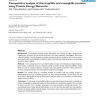Free Online Productivity Tools
i2Speak
i2Symbol
i2OCR
iTex2Img
iWeb2Print
iWeb2Shot
i2Type
iPdf2Split
iPdf2Merge
i2Bopomofo
i2Arabic
i2Style
i2Image
i2PDF
iLatex2Rtf
Sci2ools
BMCBI
2010
2010
Comparative analysis of thermophilic and mesophilic proteins using Protein Energy Networks
Background: Thermophilic proteins sustain themselves and function at higher temperatures. Despite their structural and functional similarities with their mesophilic homologues, they show enhanced stability. Various comparative studies at genomic, protein sequence and structure levels, and experimental works highlight the different factors and dominant interacting forces contributing to this increased stability. Methods: In this comparative structure based study, we have used interaction energies between amino acids, to generate structure networks called as Protein Energy Networks (PENs). These PENs are used to compute network, sub-graph, and node specific parameters. These parameters are then compared between the thermophile-mesophile homologues. Results: The results show an increased number of clusters and low energy cliques in thermophiles as the main contributing factors for their enhanced stability. Further more, we see an increase in the number of hubs in thermophiles. We also ob...
| Added | 08 Dec 2010 |
| Updated | 08 Dec 2010 |
| Type | Journal |
| Year | 2010 |
| Where | BMCBI |
| Authors | M. S. Vijayabaskar, Saraswathi Vishveshwara |
Comments (0)

